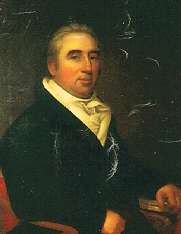William Marbury
William Marbury (November 7, 1762[1] – March 13, 1835[2]) was a highly successful American businessman and one of the "Midnight Judges" appointed by United States President John Adams the day before he left office. He was the plaintiff in the landmark 1803 Supreme Court case Marbury v. Madison.

Background
Marbury, son of William and Martha (Marlowe) Marbury, was born November 7, 1762 in Piscataway, Maryland. He spent most of his early life in Maryland around his home.
Career
Marbury became a Georgetown businessman and member of the Federalist Party. In an effort to prevent the incoming party from dismantling his Federalist Party-dominated government, Adams issued 42 judicial appointments, including Marbury's as Justice of the Peace in the District of Columbia, on March 3, 1801, the day before he turned his government over to incoming President Thomas Jefferson. Marbury had actively campaigned for Adams (and against Jefferson) in the presidential election of 1800.[3] Jefferson refused to honor Adams' appointments on the grounds that Adams' paperwork had not been delivered to the proper offices before the change of administration had taken place. Marbury then sued Jefferson's secretary of state, James Madison, in the Supreme Court, asking it issue a writ of mandamus to force the Jefferson administration to honor Adams' appointments.[4]
Marbury's suit created the right of judicial review. Supreme Court Chief Justice John Marshall's two-pronged decision averred that while the Court did not have the authority to issue the writ Marbury had requested, it had the authority to review the constitutionality of actions of the federal executive and legislative branches of government, including those of the Adams and Jefferson administrations.
Marbury never held a judicial office but had a successful career as a banker.[5]
Legacy
Marbury's former home in Georgetown is now known as "Forrest-Marbury House" and serves as the Ukrainian Embassy to the United States.[6] Chief Justice Warren Burger placed portraits of William Marbury and James Madison in the small dining room of the Supreme Court, and designated the room "the John Marshall room".[7]
Descendants include William L. Marbury, Jr. (1901–1988) of Baltimore, Maryland.[8]
See also
- Marbury v. Madison
- William L. Marbury, Jr. (probable descendant)
References
- David F. Forte, Marbury's Travail: Federalist Politics and William Marbury's Appointment as Justice of the Peace, Catholic University Law Review, p. 355 Vol 45:349.
- John Marshall and International Law: Statesman and Chief Justice by Frances Howell Rudko at Questia Online Library
- David F. Forte, Marbury's Travail: Federalist Politics and William Marbury's Appointment as Justice of the Peace, Catholic University Law Review, p. 402 Vol 45:349.
- The Marbury Mystery: Why Did William Marbury Sue in the Supreme Court?
- Whatever happened to William Marbury?
- History of Forrest-Marbury House on the Ukrainian Embassy website.
- David F. Forte, Marbury's Travail: Federalist Politics and William Marbury's Appointment as Justice of the Peace, Catholic University Law Review, p. 350 Vol 45:349.
- Smith, Richard Norton (1988). The Harvard Century: The Making of a University to a Nation. Harvard University Press. pp. 173–174 (descent), 179–180, 186, 195, 196, 246. Retrieved 2 October 2017.
External links